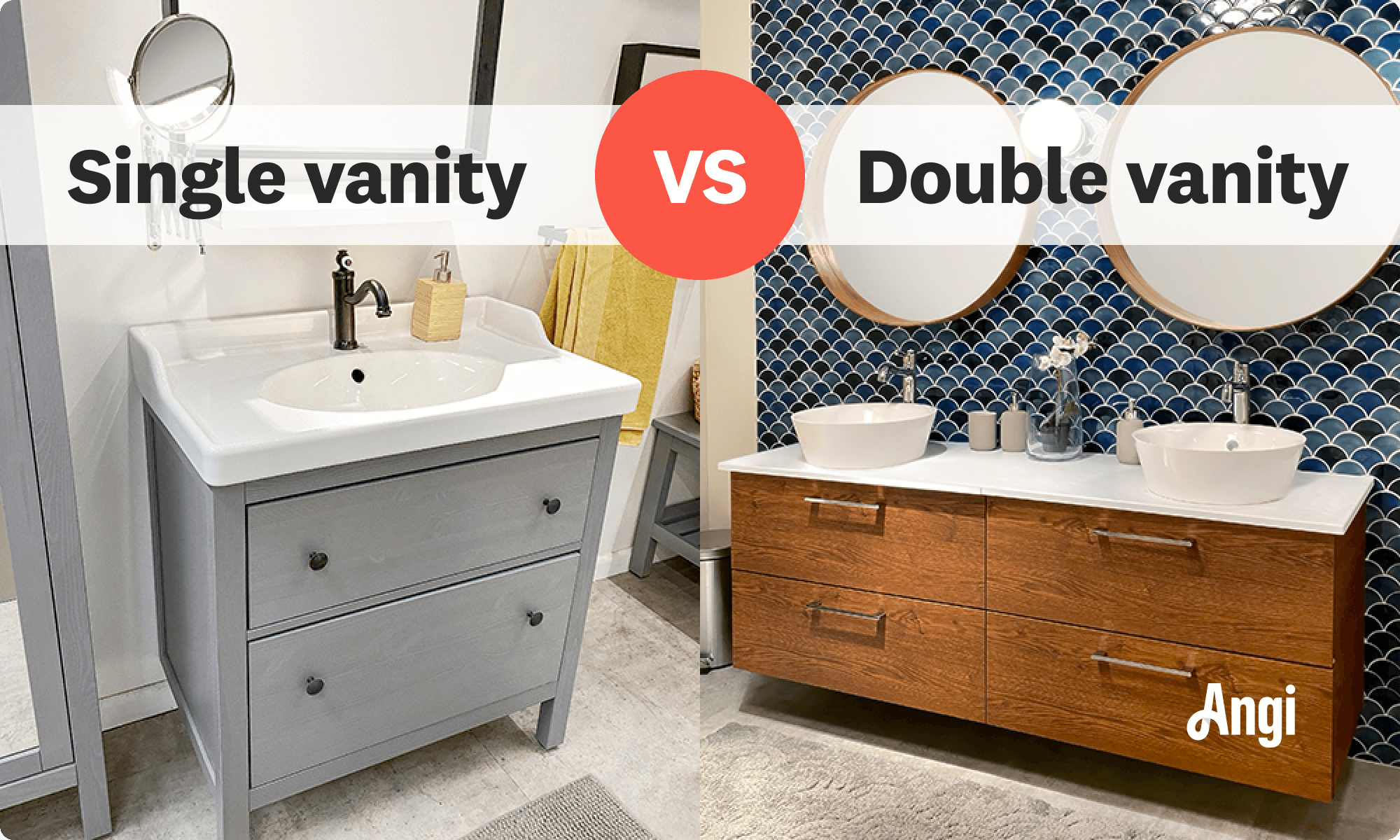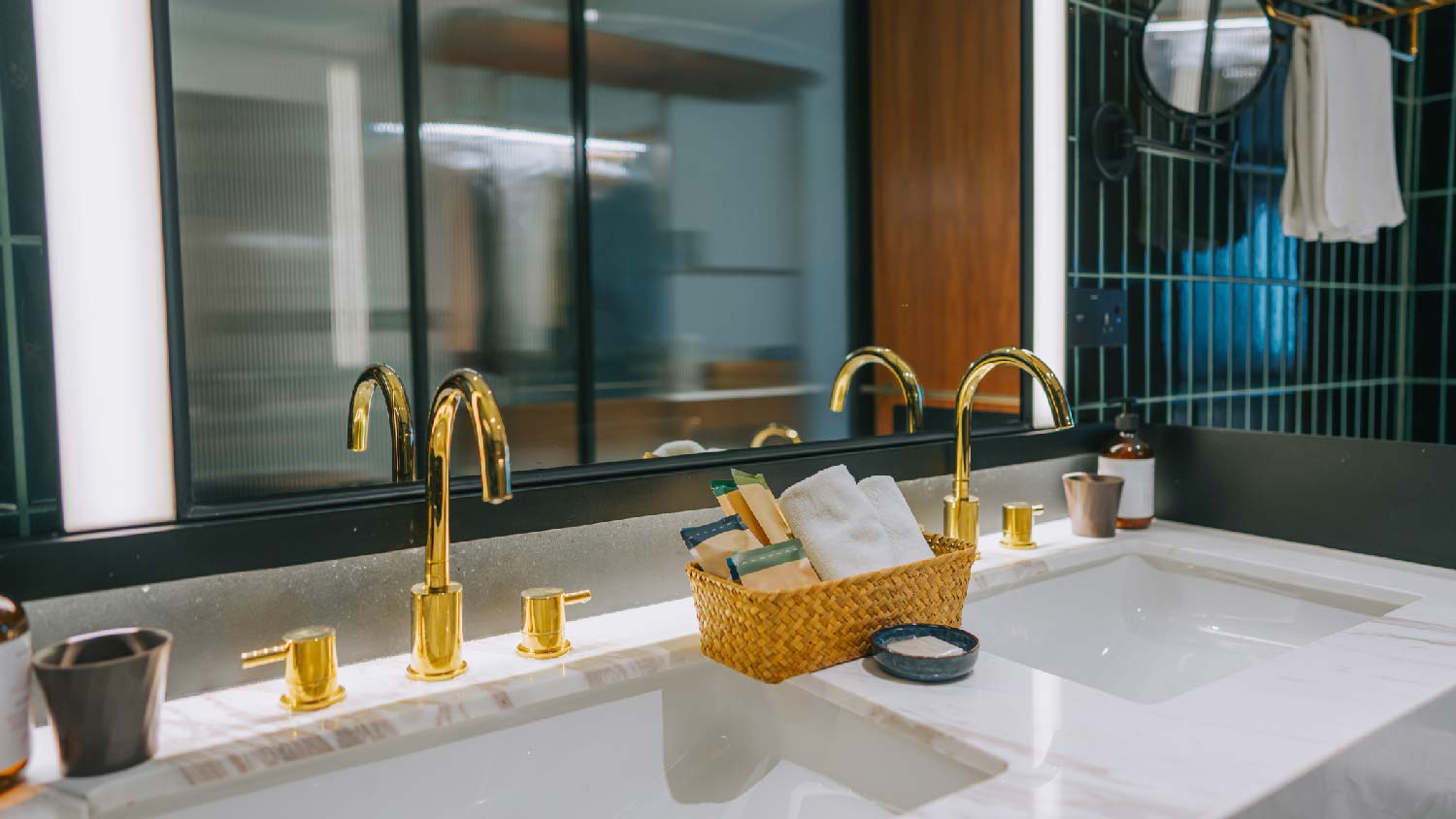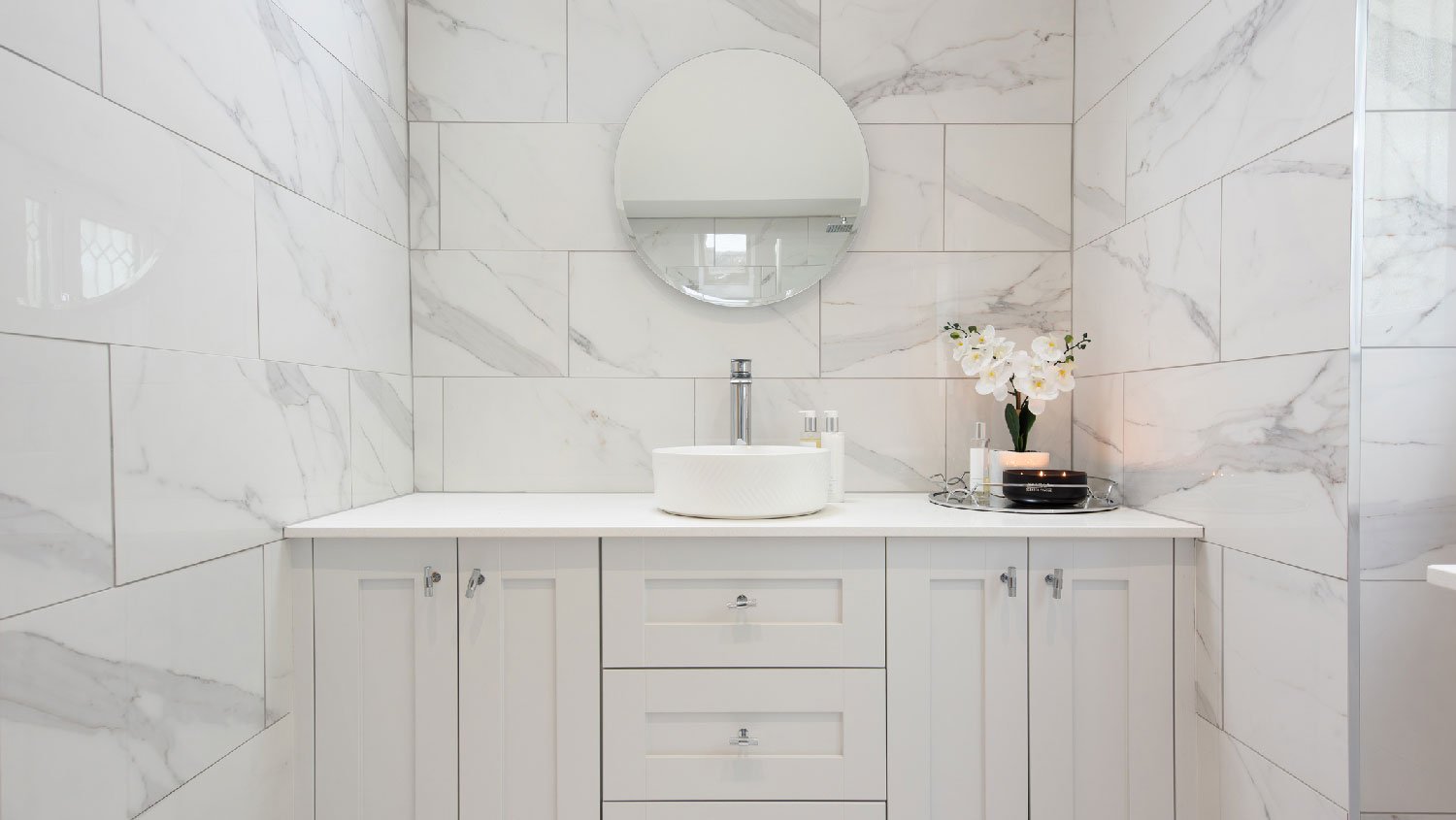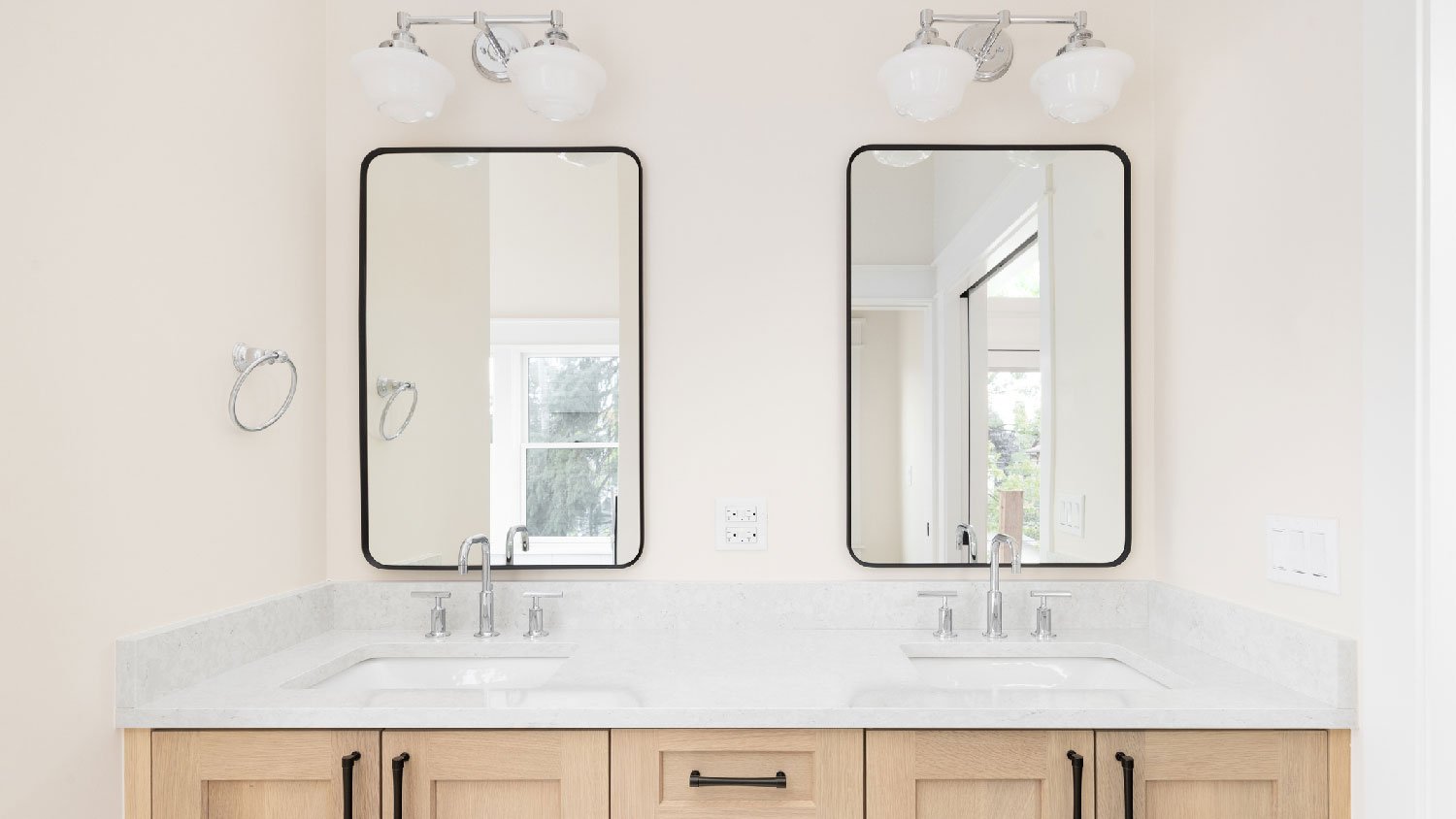Double Vanity vs. Single Vanity: Which Is Best for Your Space?
Tips for whether to stay single or make it a double


Single vanities have just one sink, while double vanities have two.
Most double vanities are between 48 and 72 inches long.
Single vanities are 18 to 48 inches but can go up to 72 inches.
Double vanities have more storage space but cost more.
Single vanities are more cost-effective but don’t give you room to spread out.
Bathroom sinks can be valuable real estate for toothbrushes and hair supplies, especially if you share a bathroom. Perhaps you need more storage space for a large household or maybe you prefer to keep things simple. Here, we discuss when to choose a double vanity versus a single vanity, their pros and cons, and how they stack up in a head-to-head sink-off.
Double Vanity vs. Single Vanity: Key Differences
One sink or two? More counter space or less? Double the drawers and cabinets or a smaller footprint? These are just a few questions you’ll need to ask yourself when choosing between single and double bathroom vanities.

What Is a Double Vanity?

Double bathroom vanities have two sinks installed in or on a longer countertop. Double vanities may start as small as 48 inches long, but the most common vanity sizes for double vanities are between 60 and 72 inches, depending on how much room is on either side of and between the sinks. If you’re unsure of which size you’ll need, a vanity installer can help you make the right choice.
| Pros | Cons |
|---|---|
| Sized for couples and shared bathrooms | Large size won’t fit in smaller bathrooms |
| Two sinks allow for simultaneous use | Large sinks can limit counter space |
| More counter space for display and storage | Can require more cleaning and maintenance |
| Double the drawer and cabinet storage | More expensive to buy |
| Balanced, charming look | More expensive to install, including plumbing |
Best for:
Larger bathrooms
Shared bathrooms with two or more users
Homeowners who need or want a lot of storage space
Those who want extra counter space for displaying items
Bathrooms that benefit from the balanced look of double vanities
Pros of Double Vanities
If you like having more elbow room and storage space or covet your own sink, a double vanity gives you room to spread out. The bigger size gives you double the counter space for display and storage, and two people can brush their teeth at the same time. You’ll also benefit from the extra drawers and cabinet space for hidden storage and the balanced look the symmetrical layout gives bathrooms.
Cons of Double Vanities
However, double sinks and extra storage take up more room, so double vanities aren’t the best idea for small bathrooms, where they can overwhelm the tight space. Having two sinks can cut into the available counter space, especially when compared to a single vanity with an oversized countertop. More space above and below the countertop also means more cleaning and maintenance.
The cost rises with double vanities, too, as they’re more expensive to purchase and install. Bathroom vanity installation costs will increase if you need plumbing work to hook up the double sinks. Their bulky size can make them harder to install, so you’ll need to rely on the help of a pro who installs bathroom vanities.
What Is a Single Vanity?

Single bathroom vanities feature just one sink and range between 16 and 72 inches in length. The most popular widths are 24, 30, 36, and 48 inches long. They’re among the most popular types of bathroom vanities for small bathrooms, guest rooms, and powder rooms.
| Pros | Cons |
|---|---|
| Fits small, tight bathroom spaces | Can look too small in bigger bathrooms |
| Available with a single sink and larger countertop | Single sink may not serve multiple users |
| Provides some storage space | Can have less counter space |
| Easier installation | Much less storage space |
| Less expensive |
Best for:
Smaller bathrooms, powder rooms, and guest bathrooms
Bathrooms used by one person
Homeowners who don’t need a lot of storage space
Those who prefer more counter space to two sinks
DIY installers
Pros of Single Vanities
If you have a smaller, tighter bathroom space, a single vanity can look more appropriate than a bigger double vanity. While they only have a single sink, you can buy single vanities with longer, larger countertops that provide even more counter space than double vanities. Unlike pedestal sinks, all single vanities offer some countertop space and hidden storage in drawers and cabinets below the sink.
The smaller size makes them less expensive and easier to install than double vanities. You may be able to do the work yourself if you’re replacing an existing single vanity and don’t need to update or change the plumbing and if you already know how to install a bathroom vanity.
Cons of Single Vanities
While saving space with a single vanity is a definite pro, size is at the heart of all cons. Their smaller footprint means single vanities look too small in bigger bathrooms. The single sink makes it hard for more than one person to use it simultaneously, so they’re not a good idea for shared bathrooms or couples. Most single vanities have less counter space than double vanities, and they almost always have less storage space unless you buy a longer vanity with a single sink.
Double Vanities vs. Single Vanities: Choosing the Best Option

Whether you go with a double vanity or single vanity depends on your needs, the space you have, and the storage and counter space you want. Here are a few categories to think about before you shop.
Counter Space: Double Vanities
Double vanities have double the counter space of single vanities, but you’ll pay for that by giving up floor space. If you have a big bathroom or need two sinks, the convenience of a double vanity makes up for the room it takes. However, if you only need one sink and want a lot of counter space, you can buy longer single vanities with only one sink and extra countertop for storage and display.
Storage Space: Double Vanities
On top and underneath, double vanities offer much more storage space than single vanities, unless you splurge on a single vanity with extra length—including extra storage space. That’s good news for people who like to have their bathroom products on display, at their fingertips, and hidden in drawers and cupboards.
Installation: Single Vanities
Their smaller size means single vanities are much easier to install. Most can slip right into place and are good candidates for DIY installation as long as the plumbing is already there. Double vanities are much larger, heavier, and unwieldy to move and install. You may need to hire a local bathroom vanity installation company to do the job.
Maintenance: Single Vanities
Single vanities tend to need less cleaning and less maintenance than double vanities. They’re smaller, have less counter and storage space, and have fewer moving parts like drawers and cabinet doors. This means you’ll likely be able to keep them cleaner and in better shape with less maintenance than larger bathroom vanities.
Cost: Single Vanities
Half the size means a lower cost, so single vanities are more affordable than double vanities. That said, you’ll pay for quality as much as quantity, so be sure to choose a quality, durable vanity regardless of which size you choose. Better quality adds up to better value, and you’ll likely get a better product and save money in the long run by choosing a long-lasting vanity that fits your space and needs. It can also lower the cost of your investment over time, as you’ll need to replace quality vanities less often than lower-quality ones.





- Bathroom Remodeling
- Kitchen Remodeling
- Shower Installation
- Stair Installers
- Bathtub Installation
- Shower Door Installers
- Kitchen Design
- Bathroom Design Companies
- Storm Shelter Builders
- Pre-Made Cabinets
- Kitchen Refacing
- Bathtub Replacement
- Ceiling Tile Installation
- Suspended Ceiling Companies
- Residential Designers
- Stair Builders
- Remodel Designers
- Shower Enclosures
- Home Renovations
- Kitchen Renovations
- Garage Remodeling
- Grab Bar Installation
- Walk-In Tub Installers
- Tub to Shower Conversion
- Balcony Contractors
- 8 Types of Bathroom Vanities for Every Space
- Floating Vanity vs. Freestanding Vanity: Which Is Best for Your Bathroom?
- The Most Common Vanity Sizes and How to Choose the Right One for Your Bathroom
- What Is a Bathroom Vanity? Everything You Need to Know for Your Remodel
- How to Protect a Bathroom Vanity From Water Damage
- What’s the Difference Between a Pedestal Sink and a Vanity?
- Single vs. Double Sinks: Pros, Cons, and Costs
- Who to Hire to Install a New Bathroom Vanity and Sink
- 11 Must-Know Bathroom Remodeling Tips for Building Your Perfect Space
- Tips to Help Repair a Water-Damaged Bathroom Vanity










